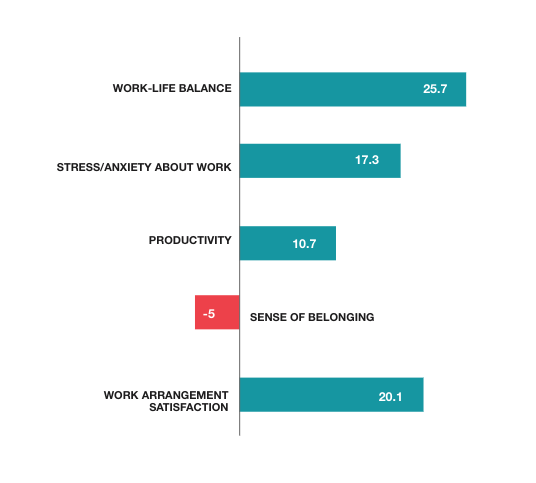
Social connection matters as much as internet connection for your employees
Thriving in the world of remote work depends on finding new ways to wire your teams’ social connections.
Posted December 9, 2020 by Sheela Subramanian
Summary and key takeaways
Since the pandemic hit eight months ago, technology has dominated the conversation about work. A good day at work depends on the quality of your wifi. “Zoom” is now a verb. And virtual collaboration happens with tools like Slack, G Suite, and Box.
Digital tools are the indispensable infrastructure of remote work. But getting plugged into the best technologies will only take you so far. Thriving in the world of remote and distributed work depends on finding new ways to wire your teams’ social connections.
Top takeaways:
- Strengthen your weak ties: Rather than only focusing on your immediate team, start with the harder work of strengthening connection with “outer circles” or “weak ties.” A network of weak ties is the foundation for a sense of community and belonging and will naturally evolve into “strong ties” and friendships over time.
- Storytelling over status checks: Personal stories cut out the professional facades and promote a sense of belonging within a team. They make people feel heard. Rather than status-oriented team meetings, consider kicking off meetings focused on the humans on the team.
- Bring the physical into the virtual world: consider how you can bring special moments of spontaneity or delight into the days of your employees in a tangible way.
The importance of social connection
Workplace connection is key to belonging and is a driver for engagement and productivity. Leaders need to invest in social connection as much as they do Internet connection. Otherwise, they will lose their best and brightest employees to isolation and burnout.
This is personal for me. As a mom of two, I had previously struggled with balancing career ambition and caregiving. After the initial shock of the pandemic wore off, my family got into a (semblance of) a routine. I found myself digging the novel rhythms of pandemic life. The newfound work/life fluidity was working for me: I was spending more time with my kids, practicing self-care in what used to be “commute time,” and Zooming with friends on Friday nights.
But the shine quickly faded. As the pandemic stretched on with no end in sight, I found that I sorely missed the social outlet that work once provided. For me, it was less about “work” and more about connecting with people about the things I was thinking about everyday: ongoing instances of racism in American society, the imminent threat of climate change as seen in the California wildfires, and the increasing mental load I was carrying as a mother and daughter of aging parents.
The day-to-day work of staring at Zoom screens felt perfunctory and made me miserable. I realized that I had been in “try to do it all during a global pandemic” mode for six months. I hadn’t taken the time to laugh, be goofy, or just connect with my colleagues. I was profoundly lonely.
Turns out, I am not the only one feeling this way. The Future Forum’s recent Remote Employee Experience Index showed the sense of belonging is the most challenging aspect of remote work. While productivity, work-life balance, and overall satisfaction with working arrangements is trending up, the difficulty of building and maintaining relationships and staying in sync with colleagues is a persistent struggle.
Results from the Remote Employee Experience Index

Our Remote Employee Experience Index asked ~5k employees working remotely to compare their experience, from “much better” to “much worse”, than working in the office, with the midpoint being “about the same as working in the office.” Remote work scored better across most elements, except for employees’ sense of belonging.
The need for belonging and connection is core to being human
As Vivek Murthy writes in Together, “humans have survived as a species not because we have physical advantages like size, strength, or speed, but because of our ability to connect in social groups.” The absence of those connections and moments can turn work into virtual multitasking.
Beyond the individual employee level, the value of emotional connections can also impact the long-term health of your business. According to research from University of Michigan’s Center for Positive Organizations, “relational energy” is the emotional capital that is gained (or lost) during every interaction. This type of energy has a cascading effect: positive interactions can unlock clarity and creativity, which ultimately leads to higher motivation for the task at hand. “The experience of relational energy with a leader increases one’s motivation at work, attention to tasks, and absorption in work activities. This translates into higher work performance.” As remote work becomes the norm, investing in strengthening social ties is both good for your people and your business.
However, the “lift and shift” methods don’t work with social ties: virtual happy hours are not (and have never been) conducive for parents with young kids with early bedtimes. The added drawback is that the virtual setup does not offer quieter employees their own “table” from socially dominant and extroverted employees.
Finding new ways to build social connection is the single most important factor that will separate organizations who thrive in the digital-first post-pandemic world from those who get left behind.
Three recommendations for investing in these ties:
1. Strengthen your weak ties
Finding time for the people on your immediate team is the easy part. Start with the harder work of strengthening connection with “outer circles” or “weak ties.” A network of weak ties is the foundation for fostering a sense of community and belonging and creating a culture of familiarity for new hires — and it will naturally evolve into “strong ties” and friendships over time.
Invest in random connections across org charts and hierarchies. Tools such as Donut can foster connection between assorted groups of people and build 1:1 ties. Ideally, these conversations are just that—without agendas or business-related conversation.
Most importantly, do not put the burden on middle managers to figure this out with their teams: the direction should come from members of leadership and they should be involved in these random pairings. In absence of the “walk down the office halls,” use these conversations to build transparency and trust with your junior employees who otherwise would not get exposure.
2. Choose storytelling over status checks
During my junior year in college, a professor started every class by asking a student to tell one story about an item that mattered to them. A few decades later, I remember many stories from that weekly session and remain close friends with several of those classmates today. Understanding the story behind the voice helped foster better conversation across the classroom, and the same could be said for the workplace. Personal stories cut out the professional facades and promote a sense of belonging within a team. They make people feel heard.
Rather than status-oriented team meetings, consider kicking off meetings focused on the humans on the team. Move beyond the traditional, cheesy ice-breaker to introspective prompts. If you have more time together, consider a facilitated “river of life” exercise to develop a shared respect of who people are and where they come from. Create a “humans of [your team]” Slack channel with simple prompts or peer-to-peer interviews. Take the time to review and talk through personal operating manuals from team members.
As a manager, it’s on you to create a psychologically safe place to operate. Many are taught from an early age to only focus on work at work. Now’s the time to foster a culture of embracing what your team members bring to work and home life every single day (and they’re essentially the same these days!).
3. A postage stamp goes a long way
After a recent project concluded, an acquaintance sent me a handwritten thank-you note. The note itself was delightful, but the fact that she took the time to write a card and put it in the mail built both trust and rapport between us. She quickly went from being “someone I liked” to “someone I trusted.” The return on that 50 cents of postage was exponential in terms of social and physical connection.
While we remain in our homes, consider how you can bring special moments of spontaneity or delight into the days of your employees in a tangible way. On the simplest level, take the time to show that you care by sending one person on your team a “thank you” or “how is first grade going for your kid?” postcard. Think about how you can bring the physical to the virtual context with a “holidays in August” gift exchange among team members. Even care packages after the conclusion of a project or start of a quarter will surprise and delight team members and break up the monotony of a day.
A few years ago, a wise colleague told me that we have “the honor of being someone’s best conversation of the day.”
While those were wise words at the time, they’ve become doubly important during this pandemic. It’s on leaders to continually invest in fostering these connections, an atmosphere of belonging, and developing a culture of shared responsibility and concern.
The upside is real: diverse teams fueled by trust, the ability to move quickly to capture opportunity, resiliency in the face of challenge. The investment is more than worth it— it could make the difference between whether your organization thrives in a digital-first world.


